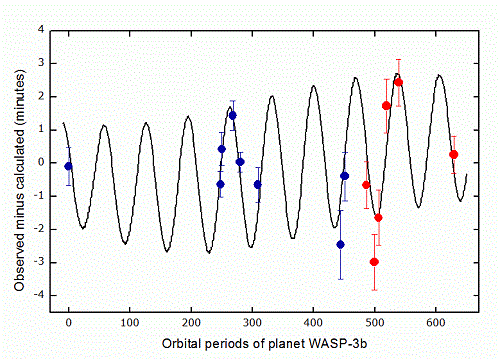Learning about planets through inference is a necessary procedure, given the state of our technology. We do have a few direct images of exoplanets now, but when relying on radial velocity data or transits, we’re looking at the effects planets cause upon our measurements of their stars. With CoRoT and Kepler now yielding high-quality transit data, it’s encouraging to see how we can go to work on this information to learn even more about the systems they study. Thus the announcement of WASP-3c, a second planet found around a star in the constellation Lyra, whose existence was pegged by its effect on the previously known planet.
WASP-3b was discovered by the Wide Angle Search for Planets project (SuperWASP), a British extrasolar planet detection program that uses robotic observatories that monitor stars for transit events. Eight wide-angle cameras monitor millions of stars, with 26 exoplanets now discovered. The new work, led by Gracjan Maciejewski (Jena University, Germany) went to work on WASP-3b using a method called Transit Timing Variation (TTV), which studies whether any variation in time between planetary transits of a known world can be detected.
The timing of known transiting exoplanets may prove to be an important tool, one that has already been studied on several transiting planet systems. If this work proves out, it will be the first planetary detection using the method. From the paper:
In a single-planet extrasolar system a planet orbits its host star on a Keplerian orbit. If one assumes that the inclination of its orbit plane is close to 90?, transits occur at equal intervals. If there is another (not necessarily transiting) planet in the system it interacts gravitationally with the transiting planet and generates deviations from the strictly Keplerian case. These perturbations result in a quasi-periodic signal in an O?C diagram [analysis of observations minus calculations] of the transiting planet.
In this case, WASP-3b, a planet of 1.76 Jupiter masses in a 1.85 day orbit around a F7-class star, is shown to be perturbed by another body. Gracjan Maciejewski comments on the find:
“We detected periodic variations in the transit timing of WASP-3b. These variations can be explained by an additional planet in the system, with a mass of 15 Earth-mass (i.e., one Uranus mass) and a period of 3.75 days. In line with international rules, we called this new planet WASP-3c.”

Image: This is the so-called O-C diagram. We plot the difference between observed (O) transit time and calculated (C) expected transit time on the y-axis in minutes versus the time given as orbital periods of the known planet WASP-3b. We plot the previously published transit times as blue dots and our own new measurements as red dots. If there would be only one planet around the star WASP-3, then all points should be on one straight line. If there would be a second planet with 15 Earth masses and 3.75 day orbital period (called WASP-3c), then this second planet would modify the orbital period of the first known planet (WASP-3b, 2 Jupiter masses in 2 day orbit) in such a way as shown by the black line, which we have calculated. This is the best fitting configuration, i.e. indirect evidence for such a new planet WASP-3c. Credit: G. Maciejewski/Jena University.
The detection is now being followed up via radial velocity studies with the 10-meter Hobby-Eberly telescope in Texas, where the new planet’s existence can be confirmed. The gravitational interactions that make Transit Timing Variation so useful are studied in terms of period and amplitude to derive the parameters of the perturbing planet, a matter of intense computer work analyzing possible configurations in a given planetary system. As we refine TTV, it’s worth noting that the method is sensitive to small perturbing planets down to Earth mass. In fact, a ‘hot Jupiter’ whose orbit is affected by a one Earth mass planet will show a definite TTV signal of up to a minute, detectable by 1-meter class telescopes.
The paper is Maciejewski et al., “Transit timing variation in exoplanet WASP-3b,” accepted at Monthly Notices of the Royal Astronomical Society and available as a preprint.



I recall a similar claim being made about the Gliese 436 system, where a super-Earth was postulated on the basis of claimed transit timing variations of the known Neptune-like planet. Eventually the proposed candidate was ruled out. Hope that doesn’t happen in this case, but right now the history of TTV detections of exoplanets seems to be that subsequent observations rule them out. (E.g. the Kepler mission recently found that there were no TTVs for TrES-2, despite previous claims for the system.)
Hi Folks;
Exoplanet detection has become a mature discipline of astronomy in its own right and this science keeps growing by leaps and bounds.
The cause for manned star flight will likely become amped way up in the relatively near term once we discover any temperate Earth like planets, or near temperate almost Earth like planets.
“With CoRoT and Kepler now yielding high-quality transit data”, we may be finding the tell tale signs of such planets sooner than one might think.
We have effectively demonstated that exoplanets are ubiquitous thanks in great part to CoRot and Kepler, and earlier exoplanet searches. Just imagine the huge set of geological, lithospheric, hydrospheric, and atmospheric characteristics that are embodied in the planets right here in the Milky Way, not to mention those within the entire visible portion of our universe, and untold realms beyond.